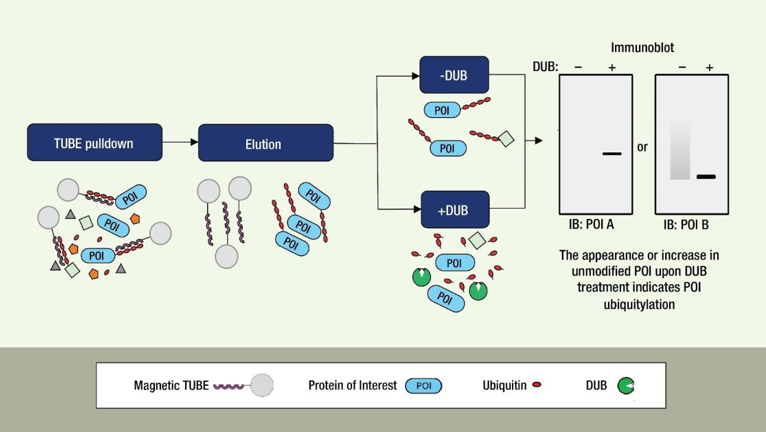LifeSensors’ UbiTest is a medium-throughput platform for measuring the polyubiquitylation levels of protein(s) of interest (POI). UbiTest utilizes TUBE technology to enrich polyubiquitylated proteins. This fraction is analyzed by immunoblotting techniques with and without pan-selective DUB digestion. The appearance or increase in the intensity of the band corresponding to the POI indicates that the POI is polyubiquitylated in the studied condition. Identification of the type of ubiquitin linkage can provide insights into the cellular functions of E3s and substrates.
Service Highlights
- Cell-based assays to measure endogenous substrate ubiquitination.
- Conversion of polyubiquitin smear of the POI to a single band in the DUB-treated fraction simplifies the quantification.
- Overcome the issue of target-specific primary antibody failing to detect ubiquitinated target protein due to epitope masking by the bulky ubiquitin chain.
- Identify the polyubiquitin linkages on the POI by digesting with linkage-specific DUBs.
- Study the effect of PROTACs or small molecules.
Related Products
Agarose-TUBE1
TUBEs display up to a 1000-fold increase in affinity for polyubiquitin moieties over the single ubiquitin binding associated domain (UBA). In addition, TUBEs protect polyubiquitinated proteins from deubiquitination and proteasomal degradation, allowing for detection at relatively low abundance.
DUBs
DUBs, or deubiquitylases are enzymes that can reverse the effect of E3 ligases by removing the ubiquitin from the target proteins. Unlike most E3 ligases, DUBs have an inherent catalytic activity that is easily targeted by small molecules.
VU1
Monoclonal antibodies that recognize polyubiquitylated proteins and free ubiquitin. VU-1 has been shown to recognize all ubiquitin linkages (mono, K6, K11, K27, K29, K33, K48, K63, and linear) by Western blotting. VU-1 is an excellent antibody for immunostaining applications generating robust ubiquitin detection and low background with an ability to detect subcellular ubiquitin localization.

